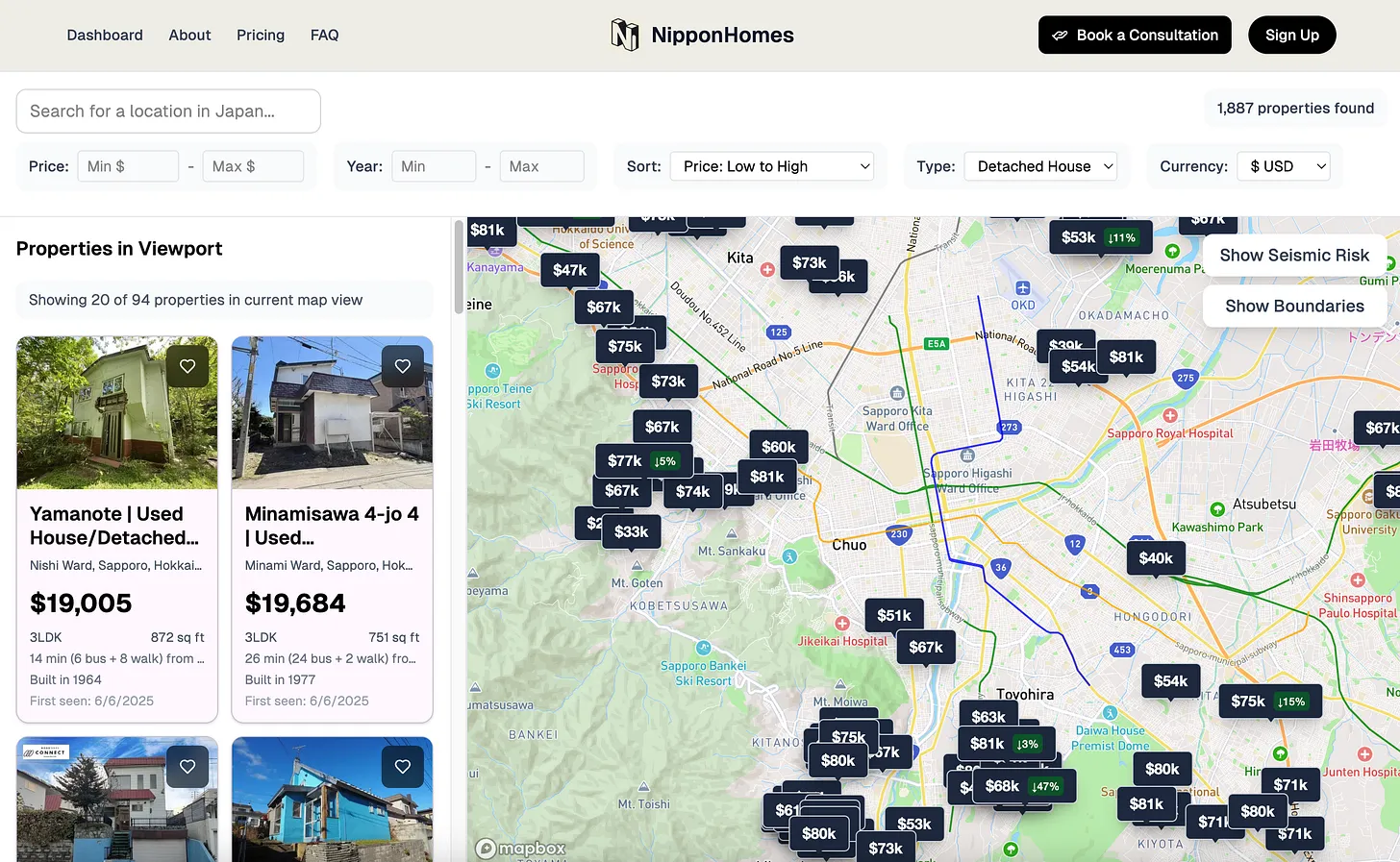So you've heard about akiya banks and you're ready to dive in. Great! Now comes the reality check: most akiya bank websites look like they were designed in 2003 and haven't been updated since. They're entirely in Japanese, use inconsistent layouts, and seem designed to confuse even native speakers.
But here's the thing—once you crack the code, they're actually pretty straightforward. After hunting through dozens of these sites for our clients, we've figured out the patterns that'll save you hours of frustrated clicking.
The Universal Japanese Property Website DNA
Every akiya bank website follows the same basic structure, even if it doesn't look like it. Here's what to look for:
物件検索 (bukken kensaku) = Property Search This is your main hunting ground. Sometimes it's a button, sometimes a dropdown menu.
賃貸 vs 売買 = Rent vs Buy
- 賃貸 (chintai) = rental
- 売買 (baibai) = for sale
価格 (kakaku) = Price Usually shows up as ¥ symbols or 万円 (man-en, meaning "10,000 yen")
築年数 (chiku nensu) = Age of building The number before 年 tells you how old the house is
The Google Translate Hack That Actually Works
Don't just translate the whole page—it'll turn everything into gibberish. Instead:
- Right-click on specific text you need to understand
- Select "Translate to English"
- Focus on key terms like addresses, prices, and contact info
- Keep a second tab open with the original Japanese for reference
For addresses, copy the Japanese text and paste it into Google Maps. Way more reliable than translated addresses.
What Those Cryptic Property Codes Actually Mean
Japanese properties love their abbreviations:
3LDK = 3 rooms plus Living, Dining, Kitchen 和室 (washitsu) = Traditional tatami room 洋室 (yoshitsu) = Western-style room DK = Dining Kitchen (smaller than LDK) S = Storage room
徒歩○分 = Walking distance in minutes 徒歩5分 = 5-minute walk (usually to the nearest station)
The Photos Tell the Real Story
Japanese property photos are brutally honest, which is actually great for buyers. If they show you a moldy ceiling or damaged tatami, that's exactly what you're getting. No staging, no fancy angles—just reality.
Look for these red flags in photos:
- Dark stains on walls or ceilings (moisture damage)
- Bent or warped window frames (foundation issues)
- Overgrown gardens visible through windows (been empty for a while)
- Old-style electrical panels (expensive to upgrade)
The Contact Process (Where Most People Give Up)
Here's where it gets tricky. Most akiya banks require you to:
- Fill out an interest form (申込書)
- Provide proof you're serious (sometimes a letter of intent)
- Go through the town's screening process
- Schedule a viewing through the municipal office
The good news? Municipal staff are usually patient with foreigners who show genuine interest. The bad news? Everything happens in Japanese and on Japanese business timelines.
Regional Differences That Matter
Hokkaido akiya banks tend to be more foreigner-friendly and organized Kyushu sites often have the best mobile optimization Tohoku regions sometimes require in-person applications only Rural Shikoku sites might not be updated regularly—call to confirm listings
Pro Tips From the Trenches
Bookmark the search results page, not individual listings. Properties disappear fast, but the search page stays consistent.
Check multiple times per week. New listings often appear without fanfare, and good ones disappear within days.
Don't trust the "last updated" dates. Many sites don't maintain these properly.
Screenshot everything. Properties can vanish from the database while you're still deciding.
When to Just Pick Up the Phone
Sometimes the website is a dead end. If you're serious about a property, call the municipal office directly. Have these phrases ready:
- "Akiya bank ni tsuite oshiete kudasai" (Please tell me about the akiya bank)
- "Eigo de hanaseru hito wa imasu ka?" (Is there someone who speaks English?)
Most larger town offices have at least one person who can handle basic English, especially in areas that actively court foreign residents.
The Reality Check
Look, navigating these sites is never going to be as smooth as browsing Zillow. They're government websites run by small town offices with limited budgets. But that's exactly why the deals are so good—most people give up before they find the gems.
Check out nipponhomes.com - the Zillow of Japan.
The houses we've found for our clients through akiya banks? The owners never would have found them on their own. Not because they're not smart enough, but because hunting through dozens of municipal websites in a foreign language is a full-time job.
That's literally what we do. While you're running your business or living your life, we're deep in the weeds of Hokkaido town websites finding properties that other agents won't even look at.
Ready to skip the frustration and get straight to the good properties? We've already done the legwork on hundreds of akiya bank sites. Let's find you something amazing.
Check out our new FREE search and discovery tool. Nipponhomes
Take the Next Step
Join our community for exclusive insights and resources on Japanese real estate investments.

Our team
Meet the founders.

Derek has been working in the Airbnb space for the past 10+ years and recently purchased a home in Japan. He is excited to bring this investment opportunity to others in the States & abroad.

Nick has a passion for adventure and has always dreamed of owning a property in Japan. His dreams finally came true when Derek brought him in on a deal of a lifetime in Hokkaido, Japan - one of Nick's favorite places on Earth.


